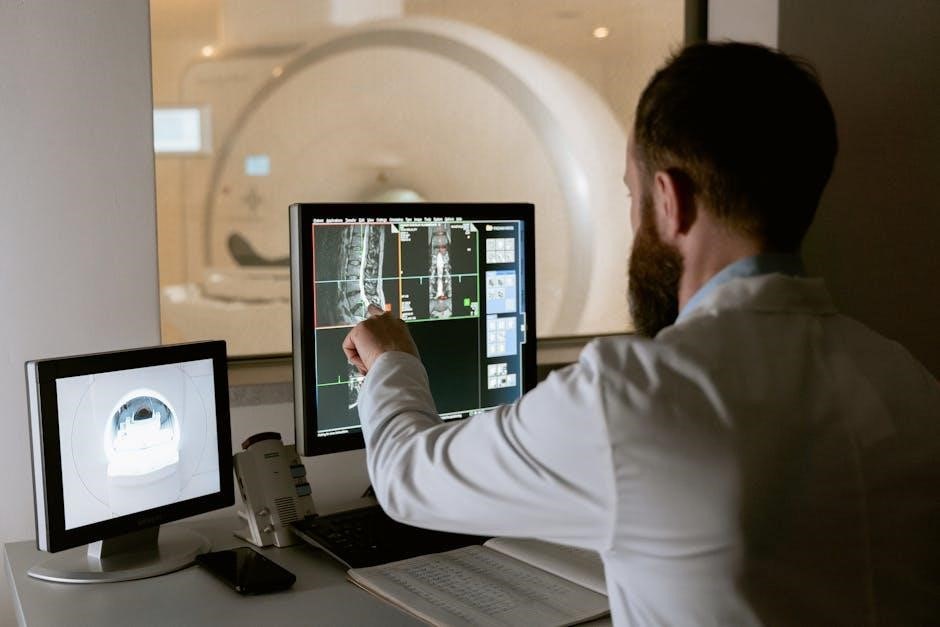Guided bone and tissue regeneration are advanced surgical techniques that promote the growth of lost bone and soft tissue‚ enhancing dental restoration and implant success rates significantly.

What is Guided Bone Regeneration (GBR)?
Guided Bone Regeneration (GBR) is a surgical technique that uses barrier membranes to promote bone tissue growth‚ essential for dental implants and treating periodontal defects effectively.
2.1 Principles of Guided Bone Regeneration
Guided Bone Regeneration (GBR) is based on the concept of using barrier membranes to guide cellular growth‚ ensuring bone tissue development in deficient areas. These membranes prevent the ingress of unwanted cells‚ such as soft tissue cells‚ into the defect‚ allowing osteogenic cells to proliferate and form new bone. The process involves precise surgical techniques‚ often combined with bone grafts or bioactive materials‚ to stimulate osteogenesis. Key principles include maintaining space for bone ingrowth‚ ensuring vascularization‚ and providing mechanical stability. Over time‚ the membrane is either resorbed or removed‚ revealing newly regenerated bone that can support dental implants or restore jaw structure effectively. These principles are crucial for achieving predictable and successful outcomes in GBR procedures.
2.2 Techniques Used in Guided Bone Regeneration
Guided Bone Regeneration (GBR) employs several advanced techniques to facilitate bone growth. One common method involves the use of barrier membranes‚ which prevent soft tissue invasion into the defect‚ allowing bone cells to regenerate. These membranes can be non-resorbable‚ such as polytetrafluoroethylene (PTFE)‚ or resorbable‚ made from materials like collagen or synthetic polymers. Another technique incorporates bone grafts‚ including autografts‚ allografts‚ or xenografts‚ to provide a scaffold for osteogenesis. Additionally‚ bioactive materials like platelet-rich plasma (PRP) or platelet-rich fibrin (PRF) are applied to enhance healing and promote tissue regeneration. Advanced surgical approaches‚ such as ridge augmentation and sinus lifts‚ are also utilized to address complex bone deficiencies. These techniques are often combined to optimize outcomes‚ ensuring sufficient bone volume for dental implants or reconstructive surgeries. The choice of method depends on the patient’s specific needs and the extent of the bone defect.
2.3 Challenges in Guided Bone Regeneration
Guided Bone Regeneration (GBR) faces several challenges that can impact its success. One major issue is the risk of membrane exposure‚ which can lead to infection and compromise the regenerative process. Additionally‚ achieving adequate blood supply and avoiding hypoxia are critical‚ as insufficient oxygen can slow down bone healing. Soft tissue invasion into the defect site is another challenge‚ as it can hinder proper bone formation. The complexity of defect morphology‚ such as large or multi-dimensional bone losses‚ also poses difficulties. Furthermore‚ the choice of membrane and grafting material must be carefully considered‚ as improper selection can affect regeneration outcomes. Patient-related factors‚ such as systemic health conditions or smoking‚ can also impede healing. Addressing these challenges requires precise surgical techniques‚ appropriate material selection‚ and post-operative care to ensure optimal bone regeneration.

What is Guided Tissue Regeneration (GTR)?
Guided Tissue Regeneration (GTR) is a surgical procedure that uses barrier membranes to repair periodontal defects by promoting the growth of new bone and gum tissue.
3.1 Principles of Guided Tissue Regeneration
Guided Tissue Regeneration (GTR) is based on the concept of using barrier membranes to prevent the ingress of unwanted cells into periodontal defects‚ allowing preferred cells‚ such as osteoblasts and fibroblasts‚ to regenerate lost tissue. The procedure relies on the body’s natural healing potential‚ guided by the membrane’s physical and biological properties. Membranes must be biocompatible‚ provide mechanical stability‚ and‚ in some cases‚ be resorbable to ensure proper tissue integration. Another key principle is the role of angiogenesis‚ as new blood vessel formation is essential for delivering oxygen and nutrients to the regenerating tissue. Additionally‚ biomaterials and growth factors play a crucial role in enhancing the healing process by creating a conducive environment for tissue growth.
3.2 Techniques Used in Guided Tissue Regeneration
Guided Tissue Regeneration (GTR) employs several techniques to facilitate the healing of periodontal defects. Barrier membranes‚ made from materials like polytetrafluoroethylene (PTFE) or collagen‚ are placed over the defect to prevent gingival epithelium and connective tissue from invading the area‚ allowing periodontal ligament cells and osteoblasts to regenerate the lost tissue. Membranes can be non-resorbable or resorbable‚ depending on the material and clinical needs. Additionally‚ techniques such as root surface biomodification‚ application of platelet-rich plasma (PRP)‚ and fibrin-rich plasma are used to enhance healing. These methods promote angiogenesis and provide a scaffold for tissue ingrowth. The choice of technique depends on the defect’s size‚ location‚ and the patient’s overall condition. Proper membrane placement and stability are critical for ensuring the success of GTR procedures.
3.3 Challenges in Guided Tissue Regeneration
Guided Tissue Regeneration (GTR) faces several challenges‚ including membrane exposure‚ which can lead to infection and compromise healing. Ensuring proper membrane stability and adaptation to the defect site is critical. Additionally‚ the use of non-resorbable membranes requires a second surgical procedure for removal‚ which may increase patient discomfort and cost. Resorbable membranes‚ while convenient‚ can degrade prematurely‚ reducing their effectiveness. Another challenge is the variability in patient healing responses‚ influenced by factors like systemic health and smoking. Anatomical limitations‚ such as defect size and location‚ can also hinder optimal outcomes. Furthermore‚ ensuring complete tissue regeneration without fibrous tissue invasion remains a difficulty. Addressing these challenges requires precise surgical techniques‚ proper material selection‚ and careful patient monitoring to maximize the success of GTR procedures.

Applications of Guided Bone and Tissue Regeneration
Guided bone and tissue regeneration are primarily used in dental implant placement and periodontal disease treatment‚ enhancing jawbone structure and supporting dental implants effectively.
4.1 Dental Implant Placement
Dental implant placement often requires sufficient bone volume for success. Guided bone regeneration (GBR) is instrumental in restoring jawbone structure‚ enabling the proper anchorage of implants. By using barrier membranes and biomaterials‚ GBR directs bone growth to deficient areas‚ ensuring a stable foundation for implants. This technique is particularly beneficial for patients with bone loss due to periodontal disease or trauma. The regeneration process allows for the successful integration of implants‚ restoring both function and aesthetics. GBR not only enhances the quantity of bone but also improves its quality‚ leading to long-term implant stability and patient satisfaction. As such‚ it is a cornerstone in modern implantology‚ addressing complex cases where bone deficiency previously limited treatment options.
4.2 Periodontal Disease Treatment
Guided tissue regeneration (GTR) plays a pivotal role in treating periodontal disease by repairing damaged bone and gum tissue. This technique uses barrier membranes to prevent the invasion of non-desirable cells‚ allowing the body to regenerate lost periodontal structures naturally. By promoting the growth of new bone and gingival tissue‚ GTR helps stabilize teeth that might otherwise be lost due to advanced periodontal damage. The procedure is particularly effective in addressing deep periodontal pockets and defects‚ halting disease progression. Additionally‚ the use of biocompatible materials and platelet-rich plasma enhances healing and tissue repair. GTR not only restores the health of the periodontal environment but also improves the overall aesthetics and functionality of the smile‚ offering a durable solution for patients with severe gum disease.

Biomaterials in Guided Bone and Tissue Regeneration
Biomaterials like polymer membranes‚ hydroxyapatite‚ and platelet-rich fibrin play a crucial role in guided regeneration‚ providing structural support and enhancing tissue repair by mimicking natural bone properties for optimal healing.
5.1 Types of Membranes Used
In guided bone and tissue regeneration‚ various membranes are utilized to facilitate healing. Non-resorbable membranes‚ such as polytetrafluoroethylene (PTFE)‚ are durable and often used for bone regeneration due to their stability. Bioresorbable membranes‚ made from materials like collagen or synthetic polymers‚ gradually degrade over time‚ reducing the need for removal. These membranes act as barriers‚ preventing soft tissue invasion and promoting selective bone or tissue growth. Additionally‚ advanced materials like hydroxyapatite-coated membranes enhance osteoconductivity‚ while others incorporate growth factors to stimulate cellular activity. The choice of membrane depends on the surgical site‚ defect type‚ and desired outcomes‚ ensuring optimal healing and tissue integration in both bone and soft tissue regeneration procedures.
5.2 Scaffolds for Tissue Engineering
Scaffolds play a pivotal role in tissue engineering by providing a three-dimensional framework that guides cell growth and tissue formation. These structures are designed to mimic the extracellular matrix‚ promoting cellular adhesion‚ proliferation‚ and differentiation. Natural scaffolds‚ such as collagen-based matrices‚ offer biocompatibility and biodegradability‚ making them ideal for soft tissue regeneration. Synthetic scaffolds‚ including those made from polylactic acid (PLA) or polyglycolic acid (PGA)‚ provide controlled degradation rates and mechanical strength‚ often used in bone regeneration. Advanced designs incorporate bioactive molecules‚ such as growth factors‚ to enhance healing. Porous and nanocomposite scaffolds further improve vascularization and tissue integration. These innovative materials are crucial for addressing complex defects‚ enabling precise tissue repair and regeneration in both bone and soft tissue applications‚ ultimately advancing the field of guided bone and tissue regeneration.


Benefits of Guided Bone and Tissue Regeneration
Guided bone and tissue regeneration offers numerous benefits‚ particularly in restoring lost bone and soft tissue. It enables successful dental implant placement by creating a stable jaw structure‚ improving aesthetics and functionality. Patients with periodontal disease benefit from the regeneration of supporting tissues‚ which helps in preserving natural teeth. Enhanced wound healing and the use of biocompatible materials reduce recovery time and minimize complications. Additionally‚ these techniques promote natural tissue repair‚ leading to long-term oral health and improved quality of life. Overall‚ guided regeneration provides a reliable solution for addressing tissue defects‚ ensuring durable and aesthetically pleasing outcomes in dental and periodontal treatments.

Leave a Reply
You must be logged in to post a comment.